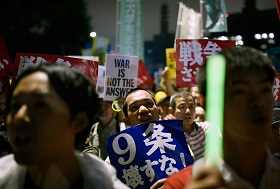Amidst the economic turbulence in China, the growing Asian middle class and intensified tensions in the South China Sea, relations between Asian countries appear to be a key factor in shaping modern global politics and the architecture of international cooperation within the Asia-Pacific region. In its turn, the Japan-ASEAN axis, apart from being one of the most institutionalized and least conflict-prone in East Asia, retains the potential for further political and economic development involving external players among others. The current state and prospects for Japan-ASEAN relations are analyzed in the Research Paper: ASEAN's Regional Role and Relations with Japan: The Challenges of Deeper Integration, prepared by the Royal Institute of International Affairs, commonly known as Chatham House. The report was published last February by a team of three authors, Masahiro Kawai, Moe Thuzar and Bill Hayton, in the wake of the conference held by Chatham House.
The Paper comprises three thematic parts, covering economic relations between ASEAN and Japan, their combined contributions towards reducing political instability in the region, and prospects for the Association’s role in the area of security. Plans to create a greater integrated community adopted by ASEAN in late 2015 gave a specific impulse to the discussion. At the same time, the strategic responses to the rise of Chinese power in the region, which worries ASEAN, Japan and other major powers with interests in the region appear to be the key issue of the publication.
The notorious power shift towards China is often discussed on a global scale as a Sino-American rivalry of the superpowers, although this “king of the hill” change is most clearly visible when projected on South-East Asia. Before the rise of China, Japan had been traditionally considered Captain Akka (Akka of Kebnekaise), if the East Asian economic miracle is conceptualized as a flock of flying wild geese. The expectations placed upon increased ASEAN involvement in resolving regional problems will indirectly depend on Japan’s readiness to take on an active regional leadership role.
Although Shinzo Abe has made Japan’s foreign policy more ambitious and proactive, the continuity of his course would remain undecided should the country’s leadership change. Referring mainly to ASEAN, the Paper’s conclusions reflect the uncertainty over the future role of Japan in the region, notwithstanding its long-standing connections to the region as a major investor, trade partner, supplier of financial assistance and mediator in political disputes.
It is worth recalling the background: after World War II, the US became the dominant actor in Southeast Asia, having contributed to the withdrawal of European colonial powers from the region that became an arena of the Soviet-American confrontation. Japan’s post-war reparations to Southeast Asian countries laid the groundwork for further large-scale economic cooperation with the region. In 1966, one year before ASEAN was created, the Asian Development Bank (ADB) was established with the assistance of the United States in order to provide loans to the countries of the region. Japan took on the leading role in the ADB and subsequently promoted integration projects, such as the Greater Mekong Subregion Economic Cooperation Program. In 1977, shortly after the first ASEAN summit, then Japanese Prime Minister Takeo Fukuda formulated the basic principles of equal and peaceful co-operation with South-East Asia, known as the Fukuda Doctrine, during his tour of the region.
Washington still maintains close defense ties with major ASEAN members: Thailand and the Philippines, along with Japan and South Korea are the key US non-NATO allies. Regardless of the lack of contractual framework, the relations between the defense establishments of Indonesia and the United States are quite close, while a constructive defense dialogue with Vietnam has become an important stage of President Barack Obama’s pivot toward Asia. Malaysia and Singapore, in turn, participate in the Five Power Defense Arrangements with Australia, Britain and New Zealand. According to American expert Evan Feigenbaum, this security architecture is part of splitting the Asian part of the world into “economic Asia,” where China is the leading trade partner, and “security Asia” which has defense agreements with the US and its allies.
ASEAN in this context is Japan’s natural foreign policy partner in search of regional responses to the growing Chinese power. So, Tokyo’s allocation of significant financial assistance to Myanmar in the past, which ran counter to Western criticism of the regime in Naypyidaw, has been interpreted as an attempt to withhold the state from becoming dependent on China [1]. Singaporean researcher Moe Thuzar welcomes in the Paper the continuation of this policy towards Myanmar. Her co-author Masahiro Kawai notes that Japanese development assistance to more economically developed ASEAN countries is gradually being reduced, while it is being stepped up for Cambodia, Laos, Myanmar and Vietnam, or the CLMV countries as they are often referred to in Japanese bureaucratic language.
Japanese official rhetoric is reluctant to use the term “China’s containment” and insists on interpreting Japan’s course as the desire to promote the status of China as a responsible power. Moreover, during the reign of Shinzo Abe, Tokyo has directly urged Beijing not to repeat the mistakes committed by Japan in the beginning and in the middle of the 20th century, namely infringement of the then status quo. At that time, Southeast Asian countries, having become objects of Japanese expansion, were among the first to suffer from the historical changes in the regional order. At that, the concepts of the Greater East Asia Co-Prosperity Sphere, proclaimed as the goal of Japanese expansion, as well as the East Asian Community initially had laid emphasis on the liberation from European colonial rule and on economic cooperation, but were later used by the warlords.
This accounts for traditional fears in the region's capitals of a possible Japanese “relapse,” which are fueled by the strengthened positions of right conservatives and revisions to the Japanese constitution that promote a more active defense policy. However, the growing tensions in the South China Sea – in particular, the concerns of Taiwan and ASEAN in relation to the Chinese “unauthorized construction” and militarization – intensify the awareness of the fact that Beijing is more likely than Tokyo to become the next “troublemaker.” The South China Sea can be considered as both the ASEAN “inland sea” and the “powder keg” of Asia, given the conflict potential of the offshore disputes.
However, the authors of the Chatham House Paper note that for all the declared commitments to closer coordination in the field of politics and security, ASEAN member states lack enthusiasm for partial surrendering sovereignty and want to keep the organization in its current predominantly economic format, which is closer the European Economic Community of the past than to the European Union of the present. According to the authors of the Paper, although such a measured pace of integration testifies rather to continued historical trends than to an ASEAN sunset, these trends indicate the remaining influence of external actors, including Japan.
The strategic importance of Southeast Asia for Tokyo is not hard to plumb: maritime trade routes and communication lines that are vital for Japan pass through the South China Sea, while ASEAN countries continue to remain Japan’s major markets, areas of investment by the country’s corporations and recipients of financial assistance. At that, geopolitical considerations in Japanese foreign policy are coupled with an adherence to such important principles as commitment to legalism, international law-making and institutional development. Moe Thuzar sees one of Japan‘s key roles in coordinating comprehensive solutions of strategic issues with its partners in the East Asia summit, along with promoting increased integration of Myanmar and Laos, which are ASEAN newcomers, with the Association’s “old-timers.”
However, the development of ASEAN internal political institutions may pose for Japan – and for the United States even more so – an acute dilemma between pragmatic interests and the declared value principles. Thus, observers of the February Summit between President Obama and ASEAN leaders emphasized the worsened situation with democracy in the region and that Washington could well “allow its interests to overwhelm its principles.”
The Paper’s authors share these worries too. On the one hand, Japan’s declared commitment to democratic values has not interfered with Tokyo’s efforts to strengthen mutually beneficial economic ties, especially in Asia, and particularly with ASEAN, which is the most successful regional integration group. Promoting their philosophy of economic development, professed to its regional neighbors as well, Japan's leaders stressed in a somewhat instructional tone that economic prosperity goes hand in hand with successful democratization and political liberalization. On the other hand, Tokyo has regularly declared its ideological closeness and unity or similarity of values in strengthened cooperation with partners both inside the region (Australia, India) and outside it (Great Britain, the USA).
As to the economy per se, it should be noted that the reaction of the Paper’s authors to the sensational, albeit not detailed China’s “One Belt, One Road” megaproject has been restrained enough. This initiative is given some attention in the Practicalities section, which confirms the limitations of a substantive discussion on this topic. The authors’ attitudes to the “construction race” in Asia differ. Bill Hayton cites the example of Indonesia, but does not assess this rivalry as a soft power battlefield between the two giants, trying to avoid a fight with the use of hard power. However, it should be noted that in case of possible complications in sea route navigation due to international tensions in the South China Sea, the value of alternative transport corridors to Europe will increase and necessitate their infrastructural “pumping.” Moe Thuzar, in turn, believes that creating social and economic infrastructure is one of the major formats to promote key regional processes.
The Paper notes the ASEAN countries’ difficulty in making a choice between the Japanese and Chinese proposals through the example of Indonesia. On the one hand, the Indonesian leadership believes that the Japanese business model and overregulation account for the loss of the Japanese to the Chinese of the Indonesian bid for the construction of a high-speed railway. On the other hand, as Indonesian experts emphasize, the degree of abiding by investment commitments by the Chinese is, in practice, just 7-10%, while for Japan and Korea this figure exceeds 70%. Thus, the Paper indirectly challenges – as applied to Southeast Asia – a widespread belief that China, unlike its competitors in infrastructure financing, appears to be the only country which is ready to put real money on a large scale and does not confine itself to mere promises. However, the choice between the bids for the construction of infrastructure in any case is less fraught with consequences than the choice of partners for the defense alliance: the ASEAN countries will be glad to hold over the decision on the latter longer than the one on their political integration.
1. Strefford, Patrick, “Foreign Debt: Distorting Japan’s ODA Diplomacy towards Myanmar”, Ritsumeikan Kokusai Kenkyū, Vol.1 19, 2006.




.jpg)


